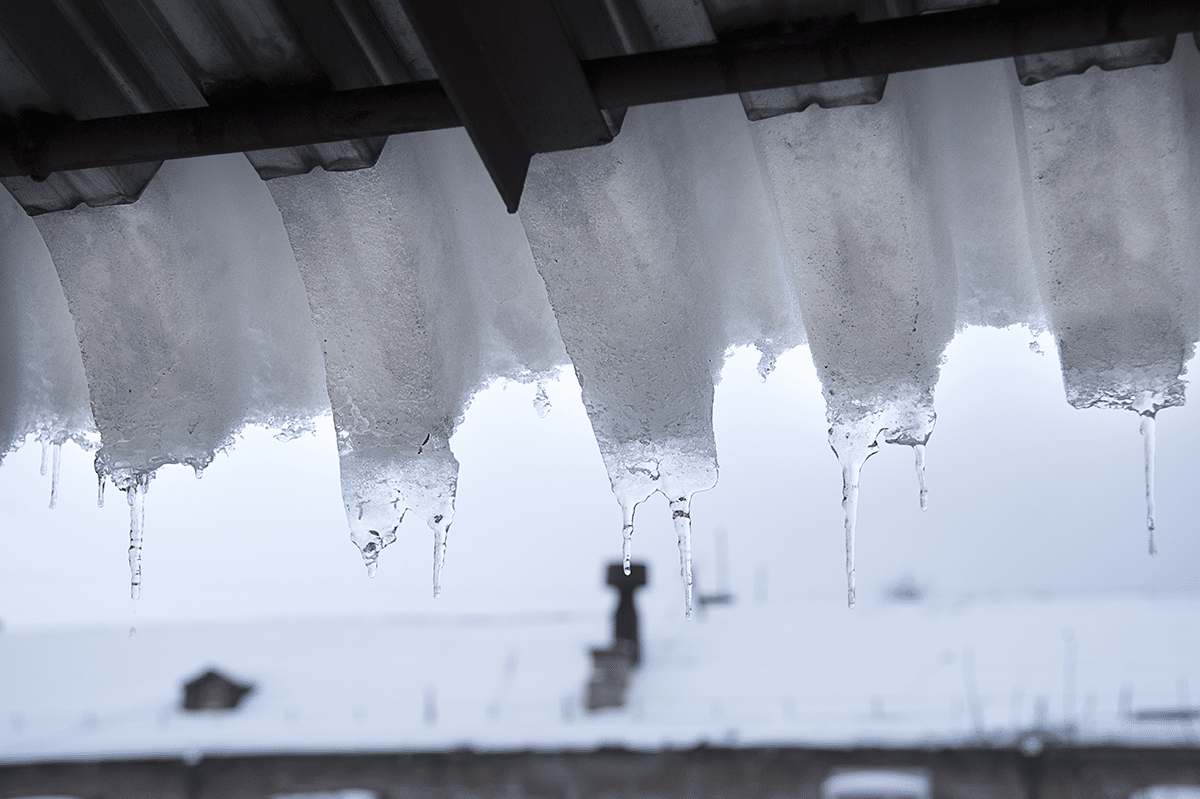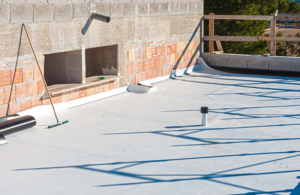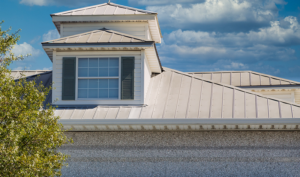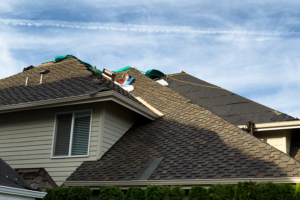When a winter storm strikes your home, it is important that you understand the type of precipitation and what winter roof effects are being created from the weather.
Freezing rain or sleet is more dangerous to your roof than standard hail. As sleet builds up into a layer of ice, it can further damage an aging or weaker roof.
When the roof is compromised by sleet during a winter storm, water can leak into your attic. Shingles and flashings can loosen, and ice dams may form.
When an ice dam forms and creates water contact with surfaces, damage occurs. Ice dams are due to a rotating cycle of low and slightly warmer temperatures, resulting in repeated ice melting and reforming.
Raised roofing nails, shingles, and flashing are areas where water from ice dams and other weather conditions such as blowing rain can enter the structure, causing leaks. As long as the weather conditions remain favorable for ice dams, any water remaining on the roof surface or under shingles will re-freeze each night as temperatures drop.
Sleet as tiny ice pellets does not allow air to penetrate as freely as it can with snowflakes. By weight, on average, 13 inches of melted snow is equal to one inch of rain, whereas two inches of sleet is equal to about one inch of rain. This is why sleet and resulting ice accumulation are so damaging to power lines. An ice storm and resulting ice dams take much longer than equivalent snow to melt. Ice dams in shaded areas of the roof edge will remain even longer.
Freezing Rain
Freezing rain is caused by overlapping cold and warm air in the atmosphere. Precipitation, usually snow, is formed high up in the atmosphere. As it falls, it travels through a layer of warm air and turns into light rain. But before hitting ground level, it moves into another layer of cold air that brings its temperature to below freezing but doesn’t have time or necessary conditions to recrystallize. When it contacts an object, like your roof, gutter, overhanging trees, and power lines, it immediately freezes.
Snow will collect and then fall off wires and tree branches and remain relatively light as it accumulates on roofs. Freezing rain as ice can weigh almost as much as water causing power outages and damage to roofs. Freezing rain is not generally a risk for roof collapse from excess weight unless it becomes unusually thick. However, freezing rain can create ice dams. The dams back up run-off water and flat roofs can suffer serious weight problems, while sloped roofs can suffer more water-penetration damage.
Ice dams formed from snowfall are very different from ice dams from freezing rain. Ice dams form by heat from the attic melting the bottom of the snow on the roof. When outside temperatures are just below freezing (15 – 32 degrees Fahrenheit), water flows down the roof under the snow and freezes when it reaches an unheated portion of the roof. This can create an ice dam on the lower edge of a pitched roof. Water can then back up under the shingles and into the roof space.
Ice Removal
In general, mechanical removal is not recommended. Removing ice mechanically from a sloped roof, with a snow rake for example, is always dangerous for the person doing it and for the roof. Devices such as shoes with ice spikes can damage roofing materials or the structure underneath the roof. If ice must be removed, have it done by a professional with proper equipment and training. In areas where ice storms are infrequent, it is best to let the sun and warmer temperatures do their work.
The first line of defense against ice dams is to maintain the attic temperature by stopping air leaks from the house below and adding sufficient insulation to the attic floor. Heating cables and other de-icing techniques are a last resort to minimize ice build-up and prevent water damage. Ice dams on your roof are often the result of the lack of a good ventilation system in your home. There is a strong relationship between attic venting, attic moisture, and Ice Dams.
Structural stress
Roof collapse is very rare except under extremely heavy snow loads. However, under freeze-thaw-freeze conditions, ice can exert intense lateral pressure on shingles and flashings. Drainage techniques can separate the ice field from flashings, leaving room for expansion and prevent damage.
Chemical De-icers
De-icing salts accelerate corrosion and should be avoided. The most common are sodium chloride (NaCl) and calcium chloride (CaCl2).
Prevention
Ice dams won’t form if the entire roof is the same temperature as the eaves. This is done by increasing ventilation, adding insulation, and sealing off air leaks that might warm the roof’s underside.
Take care of common trouble spots to prevent ice-dams and use less energy.
- Ventilate Eaves and Ridge. Ridge vents paired with continuous soffit vents circulate cold air under the entire roof. Both ridge and soffit vents should have about the same size openings and provide at least 1 square foot of space for every 300 square feet of attic floor. Place baffles at the eaves to maintain a clear path for the airflow from the soffit vents.
- Cap the Hatch. An unsealed attic hatch or whole-house fan is a large opening for heat to escape. In winter, cover them with weather-stripped caps made from foil-faced foam board held together with aluminum tape.
- Exhaust to the Outside. All ducts connected to the kitchen, bathroom, and dryer vents should exhaust to the outside through either the roof or walls, but not through the soffit.
- Add Insulation. More insulation on the attic floor keeps heat in the house and out of the attic.
- Install Sealed Can Lights. Old-style recessed lights radiate heat and can’t be insulated without creating a fire hazard. Replace them with sealed “IC” fixtures, which can be covered with insulation.
- Flashing Around Chimneys. Bridge the gap between the chimney and house framing with L-shaped steel flashing held in place with unbroken beads of a fire-resistant sealant. Using canned spray foam or insulation is not fire safe.
- Caulk Penetrations. Seal around electrical cables and vent pipes with a fire-resistant sealant. Also, look for spots where light shines up from below or where the insulation is stained black by dirt from passing air.
RESOURCES
Blue Nail Roofing has a Master Elite contractor status awarded by the largest roofing manufacturer in North America, GAF. Only 2% of contractors in the US meet the rigorous standards to achieve this status, which means you can be assured you are making a good choice when selecting the professionals at Blue Nail Roofing to execute your home and business roofing repairs. Call today to schedule a professional evaluation!
Copyright © 2020 Blue Nail Enterprises. All rights reserved. | Privacy Policy
Let Us Nail Your Project!
Send us a little information about your roofing or home improvement needs, and an expert will reach out shortly.







